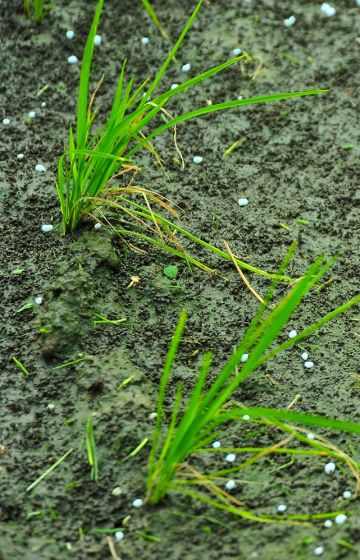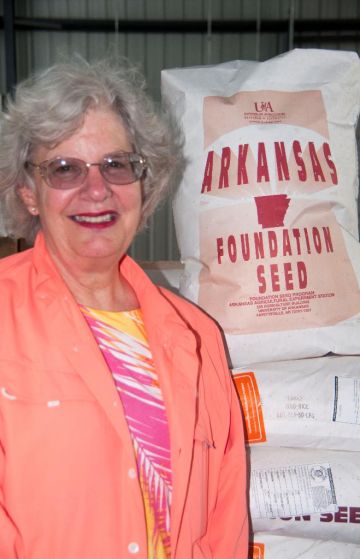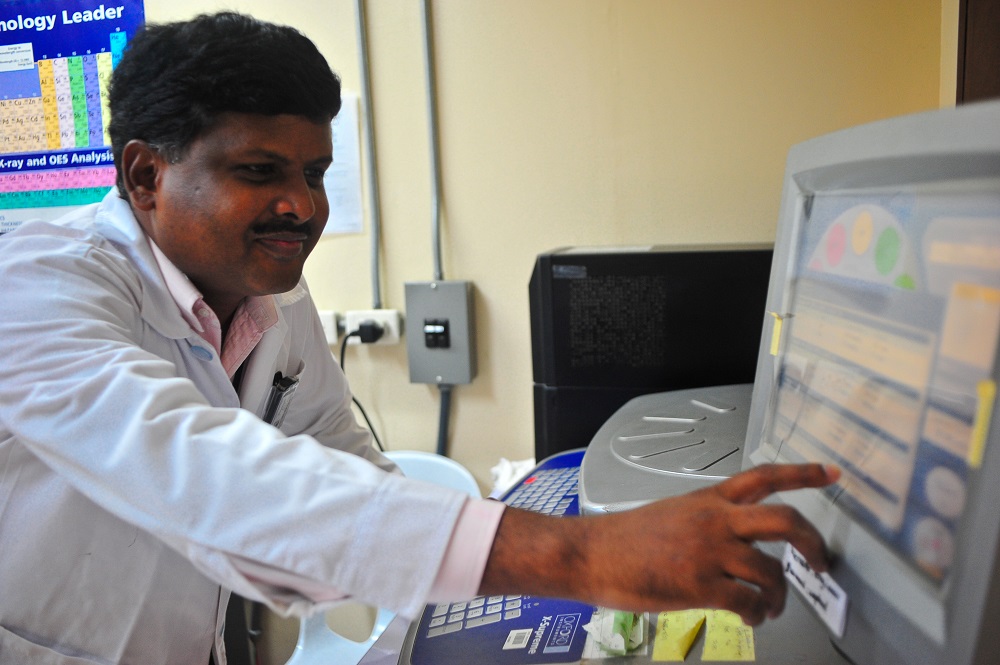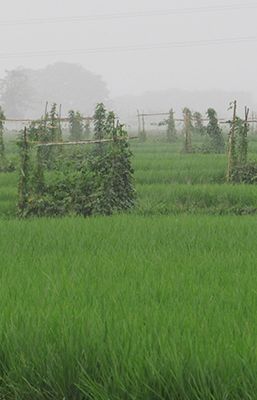Intensified rice production, combined with climate change, is causing rapid loss of biodiversity and natural resources. With billions to feed, how can we make rice sustainable?
Feeding the world while caring for the planet
The International Rice Research Institute’s new research outcome theme on developing environmentally sustainable solutions for rice systems addresses some of the challenges of improving productivity and income from rice-based systems while minimizing the environmental footprint.

Rice is probably one of the most strategic commodities for the world, closely connected with food security, economic growth, employment, culture, and regional peace. Being staple food for half of humanity or more than 3 billion people globally, it has been an instrumental crop for many countries not only to meet their food demand but also contribute to their economy by exporting the rice.
The world has made significant progress to improve rice production from 220 million tonnes in the pre-green revolution era to 729 million tonnes in 2017 to feed the growing population. The increase in the paddy production was attributed to many factors including an increase in the irrigated area, semi-dwarf high yielding rice varieties, and use of agrochemical, etc. However, the sustainability of the growth rate of the rice sector is a prime concern for the fast-growing global population to maintain food security, economic growth, quality of life, and social stability.

The cereals imperative of future food systems
The world urgently needs a transformation of the global food system, leading to healthier diets for all and a drastic reduction in agriculture’s environmental impact. The major cereal grains must play a central role in this new revolution for the benefit of the world’s poorest people.
By Martin Kropff and Matthew Morell
Pioneering research on our three most important cereal grains — maize, rice, and wheat — has contributed enormously to global food security over the last half century, chiefly by boosting the yields of these crops and by making them more resilient in the face of drought, flood, pests and diseases. But with more than 800 million people still living in chronic hunger and many more suffering from inadequate diets, much remains to be done. The challenges are complicated by climate change, rampant degradation of the ecosystems that sustain food production, rapid population growth and unequal access to resources that are vital for improved livelihoods.

CGIAR centers push recommendations for CFS Voluntary Guidelines on Nutrition and Diets
Placing the Global South front and center
Among the critical conversations had at the recently concluded CFS46 side event titled Road Testing Healthy Diets: Perspectives from the Global South was proposing research and reality-based action steps to help create an inclusive and enabling policy environment for food system transformation actors of the Global South.
Is it possible to achieve a #ZeroHunger world? #CFS46 #WorldFoodDay2019
Highlighting his points at #CGIARatCFS46, Jean Balié, IRRI platform leader for agri-food policy, gives a holistic perspective in achieving #UNSDG #ZeroHunger.
World Food Day Podcast - Achieving #ZeroHunger by 2030: How can youth lead the way?

Smart fertilizer management and the quest for sustainable rice production
Specific fertilizer recommendations in smallholder rice farming systems could increase crop production while reducing pollution and greenhouse gas emissions.
Rice production relies on the use of synthetic fertilizers, especially nitrogen, in order to meet the challenge of rising demand for the commodity driven by population growth. However, the nutrient needs of rice crops are not constant and can vary with fields, seasons, and years because of differences in crop-growing conditions and management. Consequently, the proper management of nutrients for rice production needs to be adjusted to suit field and crop requirements.
Furthermore, the application of external nutrients constitutes the second most expensive rice production input, after labor. As a result, nutrient management is an important component for sustainable rice production while protecting the environment.
Healthier rice through biofortification
Micronutrient deficiency, also known as #hiddenhunger, occurs when the quality of #food we eat does not meet our bodies’ #nutrient requirements.
Hidden hunger can be solved by eating diverse and nutritious foods. However, not everyone can afford and access nutritious foods, particularly in countries where #climatechange, #poverty, and #conflicts are severely felt.
A complementary strategy to combat hidden hunger is by increasing the #micronutrient content of our daily staples, such as #rice, which is possible through #biofortification.
Learn more: http://bit.ly/HealthierRice
BEYOND THE PLATE: Policies to achieve #ZeroHunger | Jean Balié
Addressing hunger should go beyond the plate. On #WorldFoodDay2019, Jean Balié, IRRI platform leader for agri-food policy, zooms in on various challenges, opportunities, and trade offs in developing future food policies to help achieve zero hunger for people and the planet.
For more expert insights on the future of food, visit http://bit.ly/RicetoZeroHunger
- 0:28 What are the challenges in our food system?
- 01:33 How should policies respond to food system challenges?
- 02:59 How should new food policies look like and how would that affect the market?
- 04:44 What does it take to achieve #ZeroHunger?
IPM (No, not integrated pesticide management!)
Even as we continue to promote farmer education on IPM principles and knowledge, it is important to start paying attention to the amount of investment sustaining other pest management options.

The evidence is mounting. If you drive through rural Southeast Asia between nine and eleven o’clock in the morning and roll your window down, you are likely to smell something synthetic in the air. Out in the fields, rice farmers are spraying insecticides.
Most Asian countries are importing an ever-increasing amount of pesticides. Food and Agriculture Organization of the United Nations data showed that Indonesia, Vietnam, Thailand, and India at least tripled their pesticide import values between 2000 and 2010. Many of these pesticides are used for rice production. The frequency of insecticide application in Java in Indonesia is among the highest in Southeast Asia.

The role of science, technology, and innovation in reducing poverty and hunger
Innovations are occurring in all areas of science and, like the industrial revolution in the early 1800s that saved the world from the fate of the Malthusian trap, many of today’s advances will allow us to break free of poverty and hunger.
Years ago, while I was attending graduate school at Iowa State University, Dr. Kenneth Frey challenged each of us to write a paper for his advanced plant breeding course on what we thought would make the biggest contribution to plant breeding in the future. I selected computers and little did I know in the late 1970s how much this technology would shape and influence the future of science in general.
Improving health and nutrition through rice science
Opportunities exist to improve the nutritional content of rice varieties to solve the micronutrient-deficiency problem affecting more than two billion people, mostly in rice-consuming Asian countries.

Mallikarjuna Swamy, head of the Healthier Rice Breeding Group at the International Rice Research Institute (IRRI), shares his thoughts on the role of science in solving malnutrition, particularly zinc deficiency.
“More than two billion people in the world are malnourished and most of them live in rice-consuming Asian countries,” says Dr. Swamy. He adds, however, that huge opportunities exist to improve the nutritional content of rice varieties to solve the micronutrient-deficiency problem. Scientists at IRRI and its partners are working together to bring solutions such as the high-zinc rice varieties that have been released in the Philippines and Bangladesh.

Striking a balance through ecologically engineered rice ecosystems
The high-diversity vegetation patches were designed for farmers as part of the “tool kit” of ecological engineering—a rapidly growing discipline that attempts to create managed ecosystems with benefits for both people and nature.
As our truck bounces down the narrow muddy track toward the Alubog family farm in Colonia, Bukidnon, Philippines, a huge irrigation canal, charged by the recent heavy rains, roars beside the road. The morning sun is heating up, clearing the low-lying mist to reveal a strange new landscape: a cluster of towering green pillars like the neatly arranged leafy temples of an abandoned jungle city is punctuated across the farm. The structures have attracted the attention of local farmers and are intensely monitored by scientists from the International Rice Research Institute (IRRI) and the Philippine Department of Agriculture (DA) that regularly visit this corner of Mindanao.
How we can help the Filipino farmer

For Filipinos, rice completes a meal. We love rice so much that we each consume an average of 110 kg of it per year. As the seventh highest rice-consuming country in the world, we spend 16-37 percent of our daily household food budgets on rice. Rice prices influence inflation rates and policy decisions, becoming a key barometer not just of our economy, but also of our political well-being.
With farm gate prices now at a low P15.96/kg, and an average production cost of P12 per kilo, farmers who produce 4,000 kg/harvest barely make P4,000/month. This is below the food poverty threshold of P7,337/month set by the Philippine Statistics Authority (PSA). It is no surprise, then, that families who depend on agriculture suffer higher rates of undernutrition and food insecurity.
How can we help the Filipino farmer? How rice can help in achieving #ZeroHunger. #WorldFoodDay2019.

